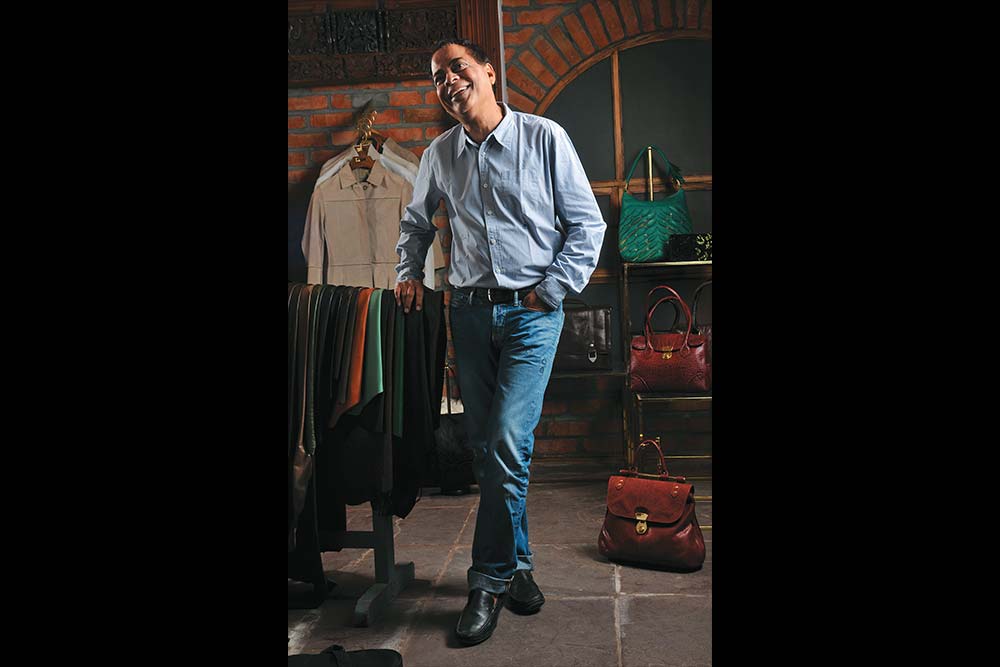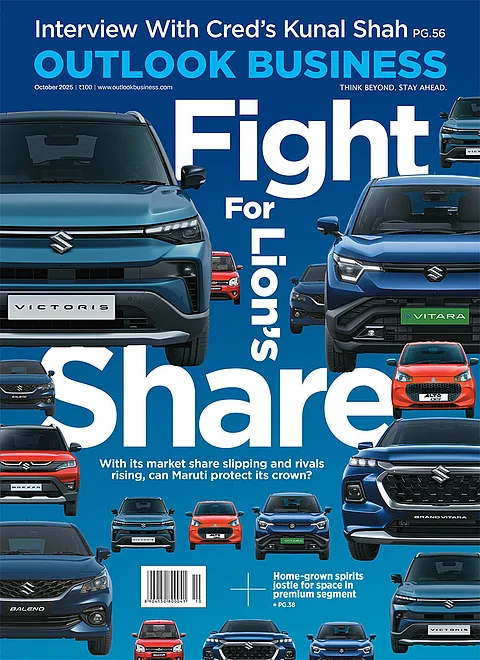It must be the prettiest leather factory anywhere. Cobble-stoned trails meander by wild undergrowth and moss-green water bodies that naturally filter waste water. Trees that did not perish in the cyclone, which hit Puducherry as 2011 ended, are propped up with ropes so that they grow more roots. As the bell rings, staff members head out to take a break and eat at stone benches under shaded groves. The entire landscape was conceived by eco-architect Ray Meeker to go with the no-asbestos, red brick workshops.
Lunch is a delicious Punjabi meal cooked in olive oil, quite the metaphor for founder-president Dilip Kapur’s ability to take an international approach to his Indian roots. “For years, I never gave a damn,” he says of his inability to see his business as, well, a business. “I never looked at a P&L account.” Does he do it now? “Yes, and I have become rather good at it,” he smiles. “I don’t think we ever made losses, but as we grew bigger, there were more bills to pay, and more responsibilities. So I am more careful now.”
Kapur, who grew up in the multicultural community of Auroville, attributes many of the environmentally sensitive and out-of-the-box ideas that define Hidesign, to his eclectic early years. Started out of curiosity as a two-man hobby in 1978, Kapur went on to establish his custom-designed factory by 1990 in the quiet Odhiampet village in the outskirts of the former French colony. To start with, Hidesign was a counter culture label that eschewed uniformity and mass production. It sold via small, alternative shops in the US, Australia and, later, the UK. Then, in 1985, upmarket British department store John Lewis started stocking Hidesign. “The world was changing,” explains Kapur. “What was alternative was becoming acceptable.”
Ever since, Hidesign has followed the multi-brand department store model for visibility and wider reach. It’s available at John Lewis, Selfridges, Liberty, Debenhams and the House of Fraser in the UK; Myer and David Jones in Australia; Edgars and Stuttafords in South Africa; Magasin Du Nord in Denmark; and Isetan, Parkson, Metrojaya and Robinsons in South East Asia. The first exclusive Hidesign store came up in 1997, in Moscow, and the label now has 12 exclusive stores outside India.
In fact, Hidesign’s India launch did not happen till 2000. “We have been very surprised by the response we have had in India,” says Kapur. “Working women in India have driven our business really strongly.” When Hidesign started in India, only 5% of the products were for women. Now, 80% are.
“Though it is easy to sell finely crafted leather products under popular global brands, creating and popularising an Indian brand for such products is highly challenging and requires huge investments,” says Ali Ahmed Khan, executive director of the Chennai-based Council for Leather Exports, a non-profit company under the Ministry of Commerce and Industry. Kapur cleverly positioned Hidesign above the mass market but below Dior and Chanel, staying resolutely focused on being an independent, global label with ‘leather crafted the forgotten way’. Hidesign’s ‘sensuous leather’ is tanned with vegetable dyes in a process that takes 30-40 days and it’s not grain corrected for obscuring defects. Solid brass hardware (buckles, logos) is moulded on-site and all Hidesign products are 80% hand-crafted. “The leather is the hero,” says Dipen Desai, brand manager, Hidesign.
Nothing to hide
At the heart of Hidesign’s appeal is its design. “I think about my client who is very demanding and wants practical elegance,” says Milan-based Alberto Ciaschini, Hidesign’s head designer since 2004, whom Kapur describes as “all heart”. “Hidesign is contemporary without losing its handcrafted identity. It’s a perfect recipe for luxury.”
“The crux of their success as a brand is that they are delivering what nobody else is,” says a member of the team with Vertebrand, the Bangalore-headquartered brand consultancy. Hidesign offers the same finish as high-end leather labels at a lower price, which makes for an easy selling point in its overseas markets. “They have been building their brand for more than three decades and they have created a value proposition which has paid off.”
In India, competitors like Samsonite offer similar products for a much higher price from a range that’s mostly made of synthetic materials. Three home-grown leather brands — Calonge, Baggit and Da Milano — are competing more directly in the south, west and north, respectively. In department stores, Hidesign is pitched against international brands like Fossil, Gas, Tommy Hilfiger, Guess and CK. Hidesign, meanwhile, plans on expanding its brand appeal with sunglasses by mid-2012. Writing instruments will follow.
The company is increasingly using the PR and promotions route to create an impact in new markets. In-store visibility through posters and promotional offers are big drivers. “We believe we have a clear and strong identity,” says Kapur. “We are usually not the second choice. Our customers either like us or they don’t. We never aimed to be something for everybody, ever.”
Product of Indian origin
“Other brands that compete in the leather goods segment with similar price points don’t offer the quality or richness of Hidesign’s leather, or its hand-made fittings and cotton linings,” says Julie Prendergast, managing director, Things Terrific Pty, a Melbourne-based supplier of leather goods to several department and independent stores in Australia, and a stockist of Hidesign since 1987. “I expect a 10% growth in business during 2011-12 in Australia, which is very encouraging considering the external economic environment.”
In India, besides retailing in large chains and opening more exclusive stores than anywhere else in the world, Kapur designs and makes bags with a distinctly ethnic and colourful tilt for Holii, a JV with the Future Group, which is quite contrary to the restrained elegance Hidesign habitually adopts. “Hidesign understands this product category like no one else,” says Ashni Biyani, director, Future Group and Holii, admitting she wooed Kapur for two years to get him to agree. Holii has eight exclusive stores and 72 retail outlets to which Hidesign brings product know-how and the Future Group provides retail expertise. “We have been doubling our growth since inception. By March, Holii will be a ₹12-crore brand. We aim to be a ₹50 crore brand by 2014,” she adds.
Kapur was initially also reluctant to retail “in a department chain like Shoppers Stop” where he was concerned whether his brand would be well-represented (having sold only in boutiques till then). However, the shop-in-shop collaboration in the ‘bridge to luxury’ space, which started in 2005, has done very well. “Mr Kapur’s recommendations have always delivered results,” says a category head who does not wish to be named. “The styles have an average sell-through of 80% plus. We have been growing year-on-year at 50% and expect the same in future.”
Hidesign currently averages ₹110 crore in annual sales. “All the growth is happening in non-European and non-American markets,” says Kapur. The fastest growth is coming from Asia, Africa and Russia. “We will be more involved in new markets.” He also wants to increase Hidesign’s presence and network in neighbouring countries such as Nepal, Sri Lanka and Bangladesh.
“Are we becoming too commercial?” he ponders in a flash of seriousness. “We mustn’t. I think we will lose our identity if we become too commercial.” Kapur particularly enjoys his association with the legendary Louis Vuitton Moët Hennessy (LVMH), which picked up 20% stake in Hidesign in 2007. LVMH has been assisting Hidesign in improving production techniques and understanding the international market for luxury brands ever since. “I have a lot of feelers but I have no interest in private equity — let the next generation do all that,” says Kapur. Of his three sons and one daughter, son Vikas is international director and CEO of Hidesign. He then adds with a laugh, “Let me have fun and retire.”












 Just one email a week
Just one email a week